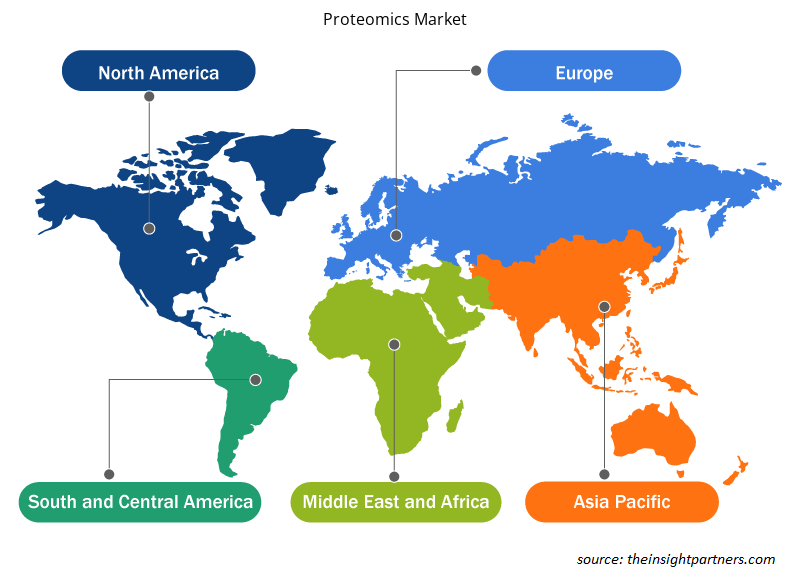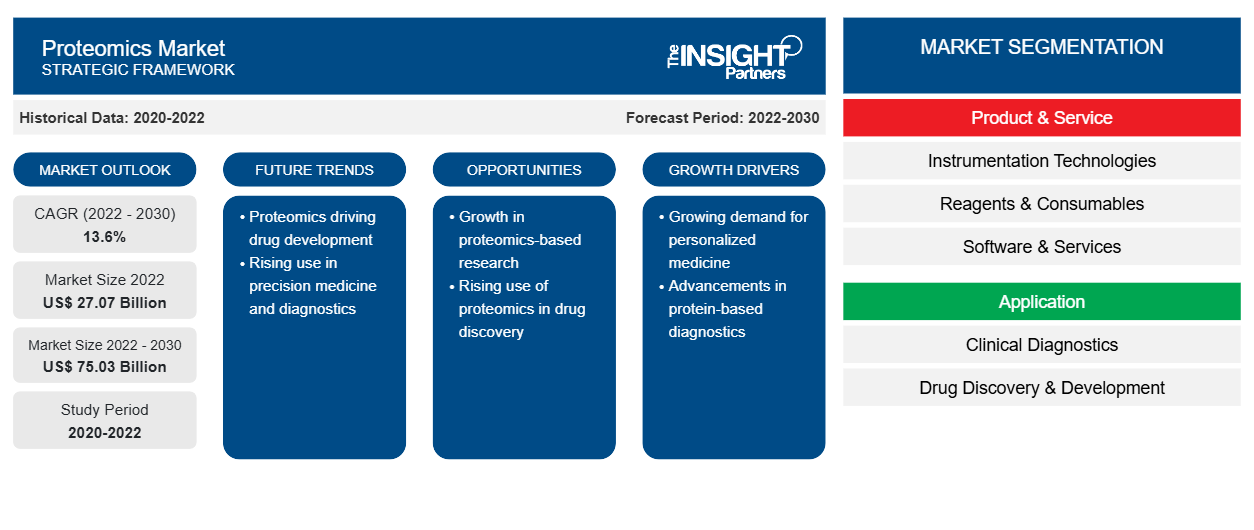[研究报告] 蛋白质组学市场规模预计将从 2022 年的 270.7 亿美元激增至 2030 年的 750.3 亿美元;预计 2022-2030 年期间的复合年增长率为 13.6%。
分析师观点:
该报告包括由于当前蛋白质组学市场趋势及其在预测期内可预见的影响而产生的增长前景。蛋白质组学是大规模蛋白质组学的研究。由生物实体形成的一组蛋白质称为蛋白质组。蛋白质组不是恒定的;它因细胞而异,并随时间而变化。蛋白质组部分反映了底层转录组,也可以定义为生物体的全部信使 RNA 分子。除了特定基因的表达水平外,还有许多因素影响蛋白质活性。蛋白质组学有许多应用。因此,由于对个性化药物的需求增加以及蛋白质组学研究和开发的增加,蛋白质组学市场预计将大幅增长。然而,严格的监管要求和熟练专业人员的缺乏阻碍了市场的增长。
市场概况:
对蛋白质结构和功能的大规模研究被称为蛋白质组学。它涵盖了快速发展的疾病蛋白质组学领域,旨在识别与人类疾病有关的蛋白质,并了解它们的表达、结构和功能如何导致疾病。推动蛋白质组学市场增长的关键因素包括癌症和其他疾病病例的增加。正在进行的蛋白质组学研究可以帮助医生了解蛋白质在高度动态的环境中如何反应,例如在癌症患者中。这是因为蛋白质组学以生物标志物的形式获得重要信息。此外,蛋白质组学已被证明取得了重大进展。此外,纳米蛋白质组学科学预计将在未来几年对市场规模产生积极影响。
定制此报告以满足您的需求
您可以免费定制任何报告,包括本报告的部分内容、国家级分析、Excel 数据包,以及为初创企业和大学提供优惠和折扣
- 获取此报告的关键市场趋势。这个免费样品将包括数据分析,从市场趋势到估计和预测。
市场驱动因素:
慢性病病例增加推动市场增长
癌症、呼吸系统疾病、慢性肾病 (CKD)、心血管疾病 (CVD) 等慢性疾病病例的不断增加是另一个有望推动市场增长的因素。例如,根据 Globocan 的数据,2020 年 12 月,全球新发现癌症病例约 1930 万例,报告癌症相关死亡病例 1000 万例。心血管疾病也是全球最常见的死亡原因之一。例如,世界卫生组织 (2021) 指出,目标疾病每年导致 4100 万患者死亡。由于危及生命的疾病病例不断增加,对个性化治疗的需求不断增长,这对行业产生了积极影响。
由于全球大量人口患有癌症,治疗需求显著增加。生命科学领域也取得了许多发现。人类蛋白质的表征是生物医学的一个里程碑。在蛋白质组水平上评估基因表达也很重要。该领域的持续研究和开发将导致蛋白质组学市场的显着增长。该技术可以提供极其重要的生物学信息,有助于了解癌症患者的生物学。这种慢性病病例的增加增强了对蛋白质组学的需求。
节段分析:
蛋白质组学市场分析已考虑以下几个部分:产品和服务、应用以及最终用户。
根据产品和服务,蛋白质组学市场细分为仪器仪表技术、试剂和耗材以及软件和服务。试剂和耗材部分在 2022 年占据了最大的市场份额,预计在 2022-2030 年期间的复合年增长率最高,为 14.1%。在预测期内,由于研究型大学、研究机构和其他领域对研究各种生物材料的试剂和试剂盒、耗材和试纸的使用越来越多,这一价值可能会增加。政府对蛋白质组学和基因组学领域的支持力度不断加大,以及疾病诊断研究活动的增加,也将推动蛋白质组学市场的增长。此外,3D 电泳蛋白分析仪等先进仪器的技术进步提高了生物研究的速度、效率和生产力,从而促进了市场扩张。
根据应用,市场分为临床诊断、药物发现和开发等。由于研究人员和临床医生广泛使用蛋白质分析来识别疾病生物标志物,以便及早发现风险因素,临床诊断领域在 2022 年占据了最大的蛋白质组学市场份额。此外,还可以发现潜在的蛋白质转录调控,可用于识别和预测恶性肿瘤并使用基于蛋白质组学的诊断评估其预后。
根据最终用户,蛋白质组学市场分为制药和生物技术公司、研究和临床实验室、医院等。制药和生物技术公司部门在 2022 年占据了最大的蛋白质组学市场份额。然而,研究和临床实验室部门预计在 2022-2030 年期间的复合年增长率最高,为 14.5%。制药和生物技术公司增加研发资金以开发新药,预计将推动对蛋白质组学服务的需求。此外,对酶、试剂和试剂盒的需求受到研发活动的增加、正在进行的几项治疗各种危及生命的疾病的蛋白质组学研究以及研究和学术环境中生命科学项目的增加的推动。
区域分析:
蛋白质组学市场报告的范围包括北美、欧洲、亚太地区、中东和非洲以及南美和中美洲。2022 年北美市场价值为 119.5 亿美元,预计到 2030 年将达到 335.6 亿美元;预计 2022-2030 年期间复合年增长率为 13.8%。推动该地区市场增长的关键因素之一是对基于结构的药物设计开发的投资不断增加、对高质量数据可重复性研究工具的需求、组学研究的增长等。人们正在关注定制治疗的开发。主要区域公司之间的伙伴关系和协作也有助于这一市场扩张。例如,赛默飞世尔科技公司和 Symphogen 合作开发了经过验证的平台流程,以优化复杂治疗蛋白的表征和质量监测。多种蛋白质疗法正在临床试验中进行测试,以治疗癌症、感染、免疫疾病、与年龄相关的疾病和其他问题。此外,由于该地区阿尔茨海默氏症等遗传疾病以及疟疾和结核病等传染病的发病率很高,蛋白质组学研究在美国等国家处于顶峰时期。
亚太地区蛋白质组学市场预计将录得最快的复合年增长率,为 14.3%。该地区,尤其是印度和中国等国家,拥有庞大的制药业。中国是制药制造中心。该地区预计的市场增长归因于该地区拥有功能齐全的制造单位和合同制造设施。此外,大量易患癌症和其他传染病的人口基数、蛋白质组学在诊断遗传疾病方面的广泛应用以及不断增加的研发支出和社会计划预计将推动对基于蛋白质组的疾病诊断的需求,从而促进市场增长。
蛋白质组学市场区域洞察
Insight Partners 的分析师已详细解释了预测期内影响蛋白质组学市场的区域趋势和因素。本节还讨论了北美、欧洲、亚太地区、中东和非洲以及南美和中美洲的蛋白质组学市场细分和地理位置。

- 获取蛋白质组学市场的区域特定数据
蛋白质组学市场报告范围
| 报告属性 | 细节 |
|---|---|
| 2022 年市场规模 | 270.7 亿美元 |
| 2030 年的市场规模 | 750.3亿美元 |
| 全球复合年增长率(2022 - 2030 年) | 13.6% |
| 史料 | 2020-2022 |
| 预测期 | 2022-2030 |
| 涵盖的领域 | 按产品和服务
|
| 覆盖地区和国家 | 北美
|
| 市场领导者和主要公司简介 |
|
蛋白质组学市场参与者密度:了解其对业务动态的影响
蛋白质组学市场正在快速增长,这得益于终端用户需求的不断增长,而这些需求又源于消费者偏好的不断变化、技术进步以及对产品优势的认识不断提高等因素。随着需求的增加,企业正在扩大其产品范围,进行创新以满足消费者的需求,并利用新兴趋势,从而进一步推动市场增长。
市场参与者密度是指在特定市场或行业内运营的企业或公司的分布情况。它表明在给定市场空间中,相对于其规模或总市场价值,有多少竞争对手(市场参与者)存在。
在蛋白质组学市场运营的主要公司有:
- 蛋白质组科学
- 生物系统
- 创新蛋白质组学
- 山塔尼
- 欧林克
免责声明:上面列出的公司没有按照任何特定顺序排列。

- 了解蛋白质组学市场顶级关键参与者概况
关键球员分析:
Proteome Sciences;Biognosys;Creative Proteomics;Shantani;Olink;SomaLogic Operating Co., Inc.;QUANTUM-SI INCORPORATED;Proteomics International;Promise Proteomics;SCIEX;Illumina, Inc.;和 Thermo Fisher Scientific Inc 是蛋白质组学市场报告中介绍的关键参与者。
最新动态:
蛋白质组学市场中的公司采用并购作为主要增长战略。根据公司新闻稿,以下列出了一些最近的市场发展情况:
- 2022 年 6 月,SomaLogic 和 Illumina, Inc. 宣布了一项联合开发协议,根据该协议,两家公司将在 Illumina 当前和未来的高通量下一代测序 (NGS) 平台上使用 SomaScan Proteomics Assay。此次合作加速了蛋白质组学市场快速增长的超高通量工作流程中的下一代测序。
- 2022 年 5 月,Proteomics International Laboratories Ltd 获得了 13,516 美元的资助,用于在澳大利亚生产其 PromarkerD 临床诊断产品,这是世界上第一个糖尿病相关肾病诊断预测测试。该计划旨在促进新的健康创新,推动发现朝着解决重要健康问题的概念验证和商业化方向发展,并最大限度地发挥创业和创意潜力。
- 历史分析(2 年)、基准年、预测(7 年)及复合年增长率
- PEST 和 SWOT 分析
- 市场规模价值/数量 - 全球、区域、国家
- 行业和竞争格局
- Excel 数据集


- Digital Language Learning Market
- Clinical Trial Supplies Market
- Data Center Cooling Market
- Playout Solutions Market
- Small Molecule Drug Discovery Market
- Pressure Vessel Composite Materials Market
- Human Microbiome Market
- Architecture Software Market
- Influenza Vaccines Market
- Adaptive Traffic Control System Market

Report Coverage
Revenue forecast, Company Analysis, Industry landscape, Growth factors, and Trends

Segment Covered
This text is related
to segments covered.

Regional Scope
North America, Europe, Asia Pacific, Middle East & Africa, South & Central America

Country Scope
This text is related
to country scope.
常见问题
The factors driving the growth of the proteomics market include the proliferating cases of chronic diseases and growing prominence of nano proteomics.
The proteomics market majorly consists of the players such as Proteome Sciences, Biognosys, Creative Proteomics, Shantani, Olink, SomaLogic Operating Co., Inc.; QUANTUM-SI INCORPORATED, Proteomics International, Promise Proteomics, SCIEX, Illumina, Inc.; and Thermo Fisher Scientific Inc.
The proteomics market is expected to be valued at US$ 75.03 billion in 2030.
The global proteomics market, based on product & service is segmented into instrumentation technologies, reagents & consumables, and software & services. The reagents & consumables segment held a larger proteomics market share in 2022, and the same is predicted to register a higher CAGR of 14.1% during 2022–2030. Based on application, market is segmented into clinical diagnostics, drug discovery & development, and others. The clinical diagnostics segment held the largest proteomics market share in 2022. However, the drug discovery & development segment is estimated to register the highest CAGR of 14.4% during 2022–2030. Based on end user, the market is segmented into pharmaceutical & biotechnology companies, research & clinical laboratories, hospitals, others. The pharmaceutical & biotechnology companies segment held the largest proteomics market share in 2022. However, the research & clinical laboratories segment is estimated to register the highest CAGR of 14.5% during 2022–2030.
The proteomics market was valued at US$ 27.07 billion in 2022.
Proteomics, the detailed analysis of proteins, has become a significant field to study drug development, therapy, prognosis, and disease characterization. Proteomics technologies help with both infectious and noninfectious disease detection and therapy. The current proteomic methodologies are being made more reliable, biocompatible, specific, and reproducible through the use of nanotechnology as a technological platform. The shortcomings of conventional proteomic techniques are greatly assessed with the use of nanomaterials to enhance the quality of proteomic techniques by protein manipulation.
Trends and growth analysis reports related to Life Sciences : READ MORE..
The List of Companies - Proteomics Market
- Proteome Sciences
- Biognosys
- Creative Proteomics
- Shantani
- Olink
- SomaLogic Operating Co., Inc.
- QUANTUM-SI INCORPORATED
- Proteomics International
- Promise Proteomics
- SCIEX
- Illumina, Inc.
- Thermo Fisher Scientific Inc.
The Insight Partners performs research in 4 major stages: Data Collection & Secondary Research, Primary Research, Data Analysis and Data Triangulation & Final Review.
- Data Collection and Secondary Research:
As a market research and consulting firm operating from a decade, we have published and advised several client across the globe. First step for any study will start with an assessment of currently available data and insights from existing reports. Further, historical and current market information is collected from Investor Presentations, Annual Reports, SEC Filings, etc., and other information related to company’s performance and market positioning are gathered from Paid Databases (Factiva, Hoovers, and Reuters) and various other publications available in public domain.
Several associations trade associates, technical forums, institutes, societies and organization are accessed to gain technical as well as market related insights through their publications such as research papers, blogs and press releases related to the studies are referred to get cues about the market. Further, white papers, journals, magazines, and other news articles published in last 3 years are scrutinized and analyzed to understand the current market trends.
- Primary Research:
The primarily interview analysis comprise of data obtained from industry participants interview and answers to survey questions gathered by in-house primary team.
For primary research, interviews are conducted with industry experts/CEOs/Marketing Managers/VPs/Subject Matter Experts from both demand and supply side to get a 360-degree view of the market. The primary team conducts several interviews based on the complexity of the markets to understand the various market trends and dynamics which makes research more credible and precise.
A typical research interview fulfils the following functions:
- Provides first-hand information on the market size, market trends, growth trends, competitive landscape, and outlook
- Validates and strengthens in-house secondary research findings
- Develops the analysis team’s expertise and market understanding
Primary research involves email interactions and telephone interviews for each market, category, segment, and sub-segment across geographies. The participants who typically take part in such a process include, but are not limited to:
- Industry participants: VPs, business development managers, market intelligence managers and national sales managers
- Outside experts: Valuation experts, research analysts and key opinion leaders specializing in the electronics and semiconductor industry.
Below is the breakup of our primary respondents by company, designation, and region:

Once we receive the confirmation from primary research sources or primary respondents, we finalize the base year market estimation and forecast the data as per the macroeconomic and microeconomic factors assessed during data collection.
- Data Analysis:
Once data is validated through both secondary as well as primary respondents, we finalize the market estimations by hypothesis formulation and factor analysis at regional and country level.
- Macro-Economic Factor Analysis:
We analyse macroeconomic indicators such the gross domestic product (GDP), increase in the demand for goods and services across industries, technological advancement, regional economic growth, governmental policies, the influence of COVID-19, PEST analysis, and other aspects. This analysis aids in setting benchmarks for various nations/regions and approximating market splits. Additionally, the general trend of the aforementioned components aid in determining the market's development possibilities.
- Country Level Data:
Various factors that are especially aligned to the country are taken into account to determine the market size for a certain area and country, including the presence of vendors, such as headquarters and offices, the country's GDP, demand patterns, and industry growth. To comprehend the market dynamics for the nation, a number of growth variables, inhibitors, application areas, and current market trends are researched. The aforementioned elements aid in determining the country's overall market's growth potential.
- Company Profile:
The “Table of Contents” is formulated by listing and analyzing more than 25 - 30 companies operating in the market ecosystem across geographies. However, we profile only 10 companies as a standard practice in our syndicate reports. These 10 companies comprise leading, emerging, and regional players. Nonetheless, our analysis is not restricted to the 10 listed companies, we also analyze other companies present in the market to develop a holistic view and understand the prevailing trends. The “Company Profiles” section in the report covers key facts, business description, products & services, financial information, SWOT analysis, and key developments. The financial information presented is extracted from the annual reports and official documents of the publicly listed companies. Upon collecting the information for the sections of respective companies, we verify them via various primary sources and then compile the data in respective company profiles. The company level information helps us in deriving the base number as well as in forecasting the market size.
- Developing Base Number:
Aggregation of sales statistics (2020-2022) and macro-economic factor, and other secondary and primary research insights are utilized to arrive at base number and related market shares for 2022. The data gaps are identified in this step and relevant market data is analyzed, collected from paid primary interviews or databases. On finalizing the base year market size, forecasts are developed on the basis of macro-economic, industry and market growth factors and company level analysis.
- Data Triangulation and Final Review:
The market findings and base year market size calculations are validated from supply as well as demand side. Demand side validations are based on macro-economic factor analysis and benchmarks for respective regions and countries. In case of supply side validations, revenues of major companies are estimated (in case not available) based on industry benchmark, approximate number of employees, product portfolio, and primary interviews revenues are gathered. Further revenue from target product/service segment is assessed to avoid overshooting of market statistics. In case of heavy deviations between supply and demand side values, all thes steps are repeated to achieve synchronization.
We follow an iterative model, wherein we share our research findings with Subject Matter Experts (SME’s) and Key Opinion Leaders (KOLs) until consensus view of the market is not formulated – this model negates any drastic deviation in the opinions of experts. Only validated and universally acceptable research findings are quoted in our reports.
We have important check points that we use to validate our research findings – which we call – data triangulation, where we validate the information, we generate from secondary sources with primary interviews and then we re-validate with our internal data bases and Subject matter experts. This comprehensive model enables us to deliver high quality, reliable data in shortest possible time.


 获取此报告的免费样本
获取此报告的免费样本